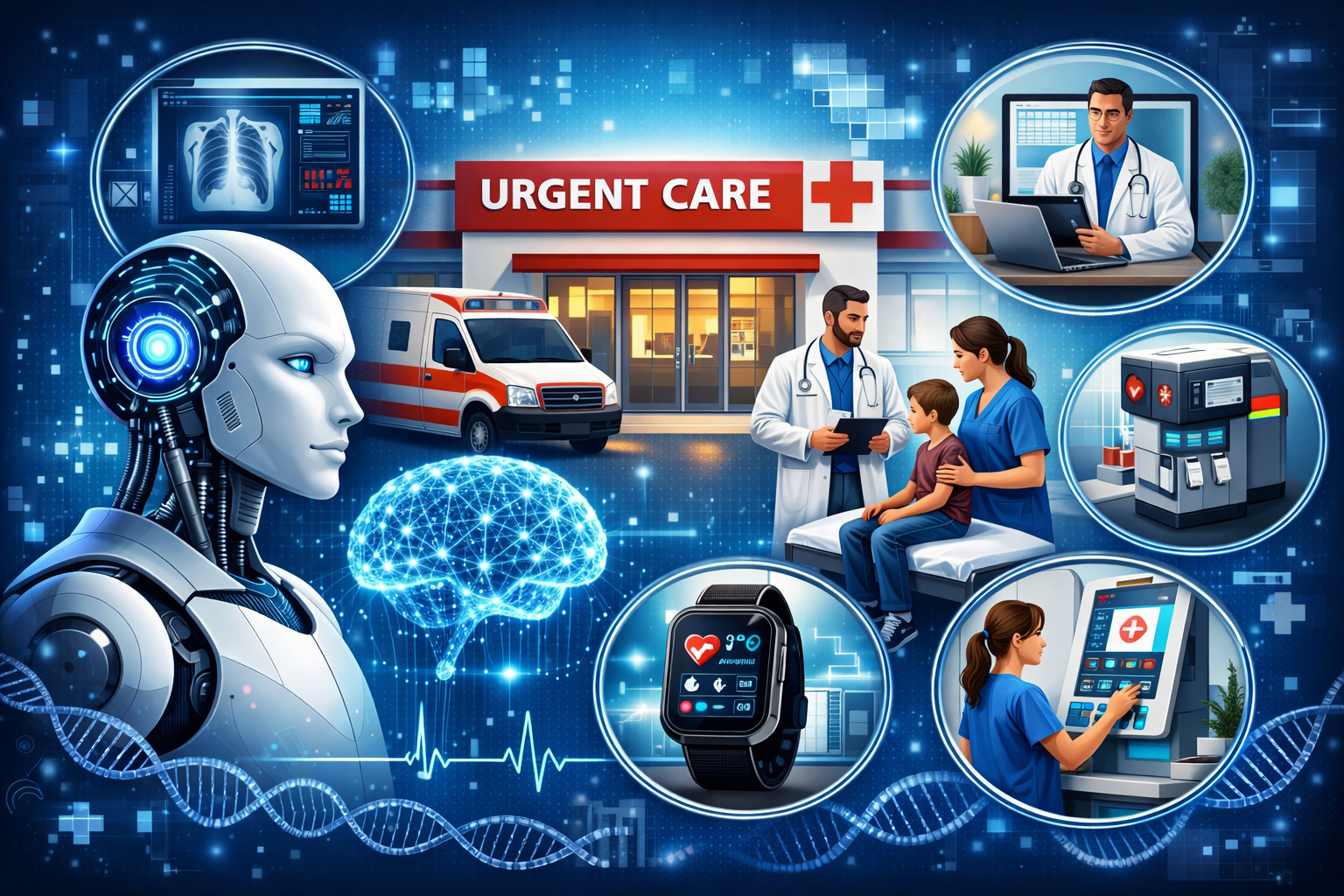As an emerging technology, AI is transforming all industries and replacing human workers to cut costs. When it comes to healthcare, it has revolutionized the dynamic landscape and is focused on improving the patient experience. Wondering how AI is changing the urgent care space? Let's explore.
In today's healthcare system, urgent care centers play a crucial role. They bridge the gap between primary care and emergency rooms, providing quick and convenient treatment for non-life-threatening conditions. However, increasing patient volumes, emergency walk-ins, staff shortages, and constant phone inquiries have made operations increasingly challenging.
This is where AI is transforming urgent care delivery. From interacting with patients to scheduling appointments and managing operations, AI is now a necessity, not a futuristic concept.
In this blog, we'll explore five key innovations that demonstrate how AI is revolutionizing urgent care and why adopting AI-powered urgent care assistants is becoming essential for modern clinics.
What Does an AI Medical Assistant Do in Urgent Care?
An AI medical assistant in urgent care works as a digital support system that helps clinics and hospitals to engage with their patients, schedule, reschedule, and cancel appointments, take regular follow-ups, complete prescription refill requests, and find an emergency doctor nearby to deliver instant care without adding pressure on staff.
In short, the urgent care AI healthcare assistant does not replace clinic front desk staff, just makes their task easier by handling time-consuming, non-clinical tasks.
Top Innovations in AI Health & Urgent Care
Innovation #1: 24*7 Patient Communication with AI Medical Assistant
One of the major challenges that urgent care centers face is communicating with patients, especially during peak hours and after closing time.
Patients often call to front-desk receptionist team to question about some services, insurance coverage, waiting time, operating hours, or exact location. Even one missed call can result in lost visits and frustrated patients.
An AI urgent care assistant here solves this issue by providing 24/7 automated communication across voice and chat channels. These assistants instantly answer patient questions, guide callers to the right services, and collect basic information before a visit.
Even after hours, patients receive immediate responses instead of getting voicemail. For front-desk clinic teams, it significantly reduces call overload and burnout. Staff can focus on in-clinic patients while the AI agent handles repetitive inquiries in the background.
Innovation #2: Urgent Care Appointment Scheduling
Compared to traditional clinics, urgent care scheduling is significantly more complex, with frequent same-day visits, reschedulings, and cancellations. Manual scheduling often leads to double bookings, long waiting times, or underutilization of providers.
AI-powered urgent care appointment scheduling keeps the entire system in sync. It checks real-time availability, facilitates same-day appointment bookings, manages cancellations, and even suggests the best visit times based on patient needs and clinic capacity. Patients can schedule appointments via phone or chat without waiting in line.
This intelligent scheduling system automates patient flow, reduces crowding in waiting rooms, and ensures efficient utilization of provider time. This clearly benefits clinics by providing greater operational control, while patients gain faster access to care.
Innovation #3: Patient Triage & Symptom Pre-Assessment
Another major innovation of AI in urgent care is AI-assisted patient triage. Before a patient even arrives at the clinic, an urgent care AI healthcare assistant gathers all the necessary information through voice or chat interactions. Based on predefined protocols, the AI helps categorize cases as urgent, non-urgent, or those requiring immediate emergency care.
Furthermore, it's important to understand that the AI doesn't just diagnose illnesses; it also assists in gathering patient information and prioritizing cases according to staff review. This reduces pre-assessment check-in times, alleviates overcrowding, and allows the clinic to be better prepared.
Want to know- Missed Appointments with Doctors - How AI Health Bot Reduces No-Shows?
By streamlining patient triage, urgent care centers can provide faster, safer, and more organized care, especially during periods of high demand such as flu season, weekends, or holidays.
Innovation #4: AI for Follow-Ups, Care Instructions, and Patient Engagement
The patient experience doesn’t end when they leave the clinic. Most of the urgent care centers struggle with post-visit follow-ups, which leads to call repetition, confusion about care instructions, and lower patient satisfaction.
AI transforms the entire healthcare operations landscape by automating follow-up communication. An urgent care AI healthcare assistant sends post-visit messages, shares care instructions, provides medication reminders, and guides patients on each and every step. These normal interactions enhance the patient care experience and can happen easily via voice calls, SMS, or chat.
Automated follow-ups reduce the burden on healthcare staff while improving care adherence and patient trust. Patients feel supported even after their visit, which strengthens loyalty and encourages positive reviews and repeat visits.
Innovation #5: Operational Insights For Urgent Care Clinics
Beyond patient-facing interactions, AI delivers powerful insights for urgent care patient management. AI systems here can analyze call volumes, peak hours, appointment trends, and understand patient demand as per their patterns over time. These insights help administrators make data-driven decisions without manual reporting.
For example, AI can identify staffing gaps, predict high-demand days, and highlight bottlenecks in scheduling or communication workflows. Clinics and hospitals can adjust their staffing levels, extend hours, and optimize resources proactively.
This operational intelligence transforms AI from a simple automation tool into a strategic asset, offering urgent care centers a direct way to improve efficiency, reduce costs, and scale sustainably.
Must Know: How AI is Transforming Patient Care? Guide to Know
Voiceoc - Delivering Smarter, AI-Driven Communication for Urgent Care
Voiceoc, an AI medical urgent care assistant especially designed by Voiceoc experts to address the communication, scheduling challenges faced by urgent care centers. As a 24/7 AI urgent care assistant, Voiceoc makes sure that no patient call or injury is unanswered, during clinic hours or after hours.
Voiceoc automates inbound calls, answers patient queries, and enables instant urgent care appointment scheduling through voice and chat. It can handle high call volumes, manage reschedules, and support patient intake without overwhelming front desk teams.
It has been built with HIPAA compliance and healthcare workflows in mind. Voiceoc here smoothly integrates with urgent care operations. And, eventually, it results in faster patient access, improved satisfaction, and directly reduced staff burnout, manages operational efficiency, and this makes Voiceoc a trusted AI partner for urgent care clinics.
Want to dive deep and know more about it? Schedule a 30-minute free consultation with Voiceoc health experts!
Challenges and the Future of AI in Urgent Care
While AI adoption offers significant benefits, it also comes with considerations. Data privacy, patient trust, and proper implementation are critical. Urgent care centers must choose AI solutions that are HIPAA-compliant and designed specifically for healthcare environments.
Looking ahead, AI in urgent care will continue to evolve. Voice-first assistants, smarter triage capabilities, deeper EHR integrations, and predictive analytics will become standard features. Clinics that adopt AI early will be better positioned to meet growing patient expectations and operational demands.
AI isn’t replacing human care; it’s enhancing it by removing friction from the urgent care experience.
Wrapping-Up
AI is fundamentally changing how urgent care centers operate and serve patients. From 24/7 communication and intelligent scheduling to triage support and post-visit engagement, these five innovations demonstrate the real-world impact of AI today.
For urgent care clinics looking to reduce wait times, improve patient satisfaction, and support overworked staff, adopting an AI urgent care assistant is no longer optional; it’s essential. With platforms like Voiceoc, urgent care providers can deliver faster, smarter, and more patient-centric care at scale.









































.png)


.svg)
.svg)




















